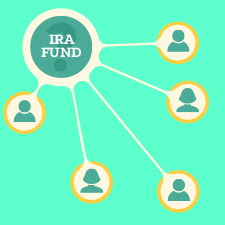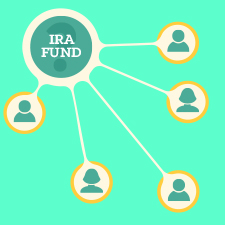Helping Your Clients Choose an IRA Beneficiary
by Commonwealth Financial Network
 IRAs are a great way for your clients to save for retirement, but they can also act as a vehicle for passing assets to their heirs. There are a number of options when choosing a beneficiary—from spouses and nonspouses to trusts and estates—and it’s not always easy to determine the best choice. Here, I’ll cover various types of beneficiaries and factors to consider when helping your clients choose an IRA beneficiary.
IRAs are a great way for your clients to save for retirement, but they can also act as a vehicle for passing assets to their heirs. There are a number of options when choosing a beneficiary—from spouses and nonspouses to trusts and estates—and it’s not always easy to determine the best choice. Here, I’ll cover various types of beneficiaries and factors to consider when helping your clients choose an IRA beneficiary.
With a household to maintain and, in many cases, dependents to support, a spouse is usually the first choice for a beneficiary. Spouses have the most options and flexibility when it comes to inheriting an IRA—making this an appealing choice. The following distribution options are available to spouses only:
- Treating assets as their own. Spouses can transfer the assets into a traditional IRA in their own name, and required minimum distributions (RMDs) will begin the year in which they reach age 70½. This can provide many years of tax-deferred growth, depending on the spouse’s age. If inheriting a Roth IRA, RMDs are not required, which may also provide additional years of tax-free growth.
- Deferring RMDs when assets are placed in an inherited IRA. Spouses can choose to defer RMDs until the year in which the decedent would have turned 70½.
In addition to delaying RMDs, spouse beneficiaries can use the inherited IRA option to their advantage if they intend to take distributions and are under age 59½. When spouse beneficiaries under 59½ treat the funds as their own, any distributions from the account are subject to the 10-percent premature penalty; however, by putting the assets in an inherited IRA, spouses can take out distributions without penalty, regardless of their age.
Given these benefits, naming a spouse beneficiary may sound like the obvious choice. Still, there are questions to be asked. Does the spouse need the money? Or does he or she already have sufficient retirement income? If so, the assets might benefit the original owner’s children more. Does the IRA owner have children from a previous marriage? In this case, it may be in the family’s best interest to have multiple primary beneficiaries so that everyone receives a percentage of the assets.
After spouses, children are the next most commonly designated beneficiary. Have your clients ask themselves the following questions before naming their children as beneficiaries:
- How old are their children? Are they minors? The younger the child, the longer the RMD payments can be stretched out. If the child is a minor, however, be aware that a custodian will control the account and will be making the decisions until the minor reaches the state’s legal age of majority.
- If naming multiple children, what percentage should each receive? Which child should be listed as primary or contingent? Should any children be excluded? Often, clients want to split the IRA equally among their children. Sometimes, however, one child may be more financially stable than another, or one may not want to be entitled to the assets at all.
- What are the children’s financial needs? A child planning to go to college may need more financial assistance than one who is not, and a child who is in debt may need more assistance than one who isn’t.
- Are they financially responsible? Would assets be better left to a trust? An individual beneficiary would generally have better distribution options than a trust. But if he or she is not financially responsible, naming a trustee may be in the best interest of the child.
Other nonspouse beneficiaries include elderly parents who can’t provide financially for themselves or nieces and nephews if the IRA owner has no spouse or children. In any case, the biggest benefit of directly naming an individual as the beneficiary is the ability to stretch out RMD payments using the beneficiary’s own age. In most scenarios, the beneficiary is younger than the decedent, so a longer life expectancy would allow for tax-deferred growth and smaller tax liabilities, as the payments would be smaller than if the decedent’s life expectancy were used.
Naming a trust as an IRA beneficiary can be complex, be costly to create and maintain, and limit distribution options. Even so, it may be the best choice if your clients want to leave assets to individuals but don’t think those heirs could manage the money themselves. For example, a teenager may not understand the full potential of having an inherited IRA and may spend the money all at once. By leaving the funds to a trust, the trustee can execute the decedent’s wishes for the beneficiary and distribute the money accordingly.
The main benefit of naming a trust is that your client keeps control of how the assets are handled after death. A trust document will dictate the beneficiaries, how much will be distributed, and when those funds will be available, plus appoint a trustee to execute those instructions. If a potential beneficiary is a minor, financially irresponsible, or disabled, this option should be highly considered.
When assessing the distribution rules for a trust, you’ll need to determine whether the trust is qualified or nonqualified. It’s best to consult an attorney who can review the trust document to confirm this.
Qualified trust. Here, the trust beneficiary can stretch out RMD payments using the oldest trust beneficiary’s life expectancy. When there are multiple trust beneficiaries, this may not be the best way to stretch out payments, as a younger beneficiary would have to use the oldest beneficiary’s life expectancy, resulting in higher payments. A trust with a single beneficiary, on the other hand, would have the benefit of using that one beneficiary’s life expectancy while still having a trustee control the account.
Nonqualified trust. In this case, beneficiaries will generally follow the same rules as for other nonindividual beneficiaries (e.g., estate beneficiaries).
In most cases, naming an estate is the least beneficial option, especially if the client has relatives who would benefit from being directly named. Estate beneficiaries have the fewest distribution options and are controlled by the decedent’s will. More important, if an IRA is left to an estate, the probate court may consider the account as an asset of the estate, and it could be subject to creditor claims.
The biggest downside to both estate and nonqualified trust beneficiaries is that, depending on the decedent’s age at death, RMDs can be based only on the decedent’s life expectancy or else the account balance has to be depleted within five years of the decedent’s death. If a decedent’s age is being used for the RMD, payments will most likely be much greater than if a younger beneficiary had been directly named. The benefit of tax-deferred growth would be diminished, and the possibility of higher tax consequences in the year of distribution would become greater.
Once your client has decided on an IRA beneficiary, best practice is to regularly review that decision to ensure that it continues to align with the owner’s estate planning goals. It’s especially important that clients review beneficiary designations when going through a life-changing event. For example:
- Individuals who have divorced and remarried should change their beneficiary immediately. If they don’t, once they pass away, the ex-spouse may be entitled to the assets if he or she is the primary beneficiary on file.
- If a child is born, an individual may want to add the child as a contingent beneficiary so that a primary beneficiary (e.g., a spouse) can disclaim the assets if he or she doesn’t need the money, which can then go to the child.
- If a beneficiary on file predeceases the IRA owner and no other primaries or contingents exist, the beneficiary will most likely default to the IRA owner’s estate. Although having an estate beneficiary may not be the worst option, the assets may not go where the deceased individual intended, and distribution options are limited.
Ensuring that your clients’ loved ones are taken care of financially, while helping those clients save for retirement, is an important part of financial planning. By taking these factors into consideration, you can help your clients accomplish both with their retirement strategy.
Do you regularly check that your clients' IRA beneficiary designations are up to date? What are other factors do you consider when helping making the beneficiary decision? Please share your thoughts with us below!
This material has been provided for general informational purposes only and does not constitute either tax or legal advice. Although we go to great lengths to make sure our information is accurate and useful, we recommend you consult your tax advisor or legal advisor regarding your specific circumstances.
Commonwealth Financial Network is the nation’s largest privately held independent broker/dealer-RIA. This post originally appeared on Commonwealth Independent Advisor, the firm’s corporate blog.
Copyright © Commonwealth Financial Network

















